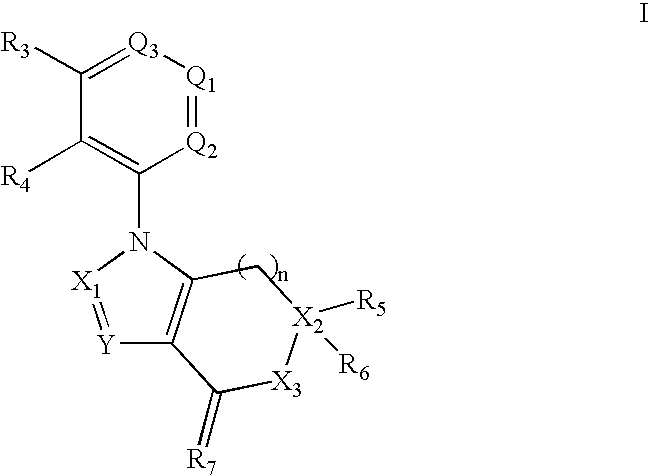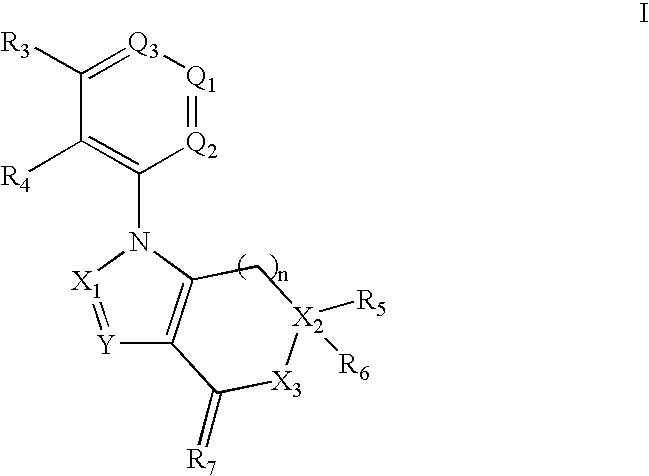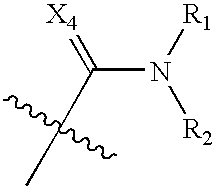Benzene, pyridine, and pyridazine derivatives
a technology of pyridine and benzene, which is applied in the field of benzene, pyridine, and pyridazine derivatives to achieve the effect of enhancing the overall effectiveness of therapy
- Summary
- Abstract
- Description
- Claims
- Application Information
AI Technical Summary
Benefits of technology
Problems solved by technology
Method used
Image
Examples
example 1
[0535]
3,6,6-Trimethyl-1,5,6,7-tetrahydro-indol-4-one (Compound 1)
[0536]To a solution of anti-pyruvic aldehyde-1-oxime (10 g, 1 eq) and 5,5-dimethyl-1,3-cyclohexanedione (16.1 g, 1 eq) in HOAc—H2O (7:3, 200 mL) was added zinc powder (14.95 g, 2 eq) slowly with cooling by a water bath at room temperature. The mixture then was refluxed overnight, concentrated to dryness, partitioned between brine (300 mL) and dichloromethane (300 mL). The pH was adjusted to ca. 6 with saturated aqueous NaHCO3, then the mixture was extracted with dichloromethane (3×200 mL). The organic layers were combined, dried over Na2SO4, filtered, concentrated. The crude product was purified by flash chromatography eluting with 5% ethyl acetate in dichloromethane. The combined organic fractions were concentrated, triturated in ether-hexane (2:1) for 1 hour, then filtered, washed with hexane to give the pure title compound (9 g, 45% yield) as a solid. LCMS m / z: (M+H)=178.1.
example 2
[0537]
2-Bromo-4-(3,6,6-trimethyl-4-oxo-4,5,6,7-tetrahydro-indol-1-yl)-benzonitrile (Compound 2)
[0538]The title compound of Example 1 (9.8 g, 55.3 mmol) and 2-bromo-4-fluorobenzonitrile (13.27 g, 66.4 mmol) were dissolved in anhydrous dimethylformamide (DMF, 300 mL). To this was added sodium hydride (95%, 2.79 g, 111 mmol) and the reaction was stirred at 55° C. for 1 hour. The reaction mixture was cooled to room temperature and water was added. A tan solid precipitated which was filtered, washed with water and ether and then dried in vacuo (16.5 g, 84%). LCMS m / z: (M+H)=358.1.
example 3
[0539]
2-(trans-4-Hydroxy-cyclohexylamino)-4-(3,6,6-trimethyl-4-oxo-4,5,6,7-tetrahydro-indol-1-yl)-benzamide (Compound 3)
[0540]A “Personal Chemistry” microwave vial was charged with the title compound of Example 2 [2-Bromo-4-(3,6,6-trimethyl-4-oxo-4,5,6,7-tetrahydro-indol-1-yl)-benzonitrile (1.072 g, 3.0 mmol)], trans-4-aminocyclohexanol (1.382 g, 12.0 mmol), palladium (II) acetate (33.7 mg, 5 mol %), 1,1′-bis(diphenylphosphino)ferrocene (DPPF) (166.3 mg, 10 mol %), and sodium tert-butoxide (576.7 mg, 6.0 mmol). To this was added toluene (20 mL) and the reaction was heated with microwave irradiation to 115° C. for 15 min. After allowing the reaction vessel to cool, a suspension formed and was filtered and the filtrate evaporated. The residue was purified by flash chromatography. The intermediate product was hydrolyzed by dissolution in 25% dimethylsulfoxide / ethanol, adding 0.5 mL of 1 N sodium hydroxide and 0.5 mL of 30% aqueous hydrogen peroxide, followed by stirring at room tempera...
PUM
| Property | Measurement | Unit |
|---|---|---|
| temperature | aaaaa | aaaaa |
| temperature | aaaaa | aaaaa |
| pH | aaaaa | aaaaa |
Abstract
Description
Claims
Application Information
 Login to View More
Login to View More - R&D
- Intellectual Property
- Life Sciences
- Materials
- Tech Scout
- Unparalleled Data Quality
- Higher Quality Content
- 60% Fewer Hallucinations
Browse by: Latest US Patents, China's latest patents, Technical Efficacy Thesaurus, Application Domain, Technology Topic, Popular Technical Reports.
© 2025 PatSnap. All rights reserved.Legal|Privacy policy|Modern Slavery Act Transparency Statement|Sitemap|About US| Contact US: help@patsnap.com



